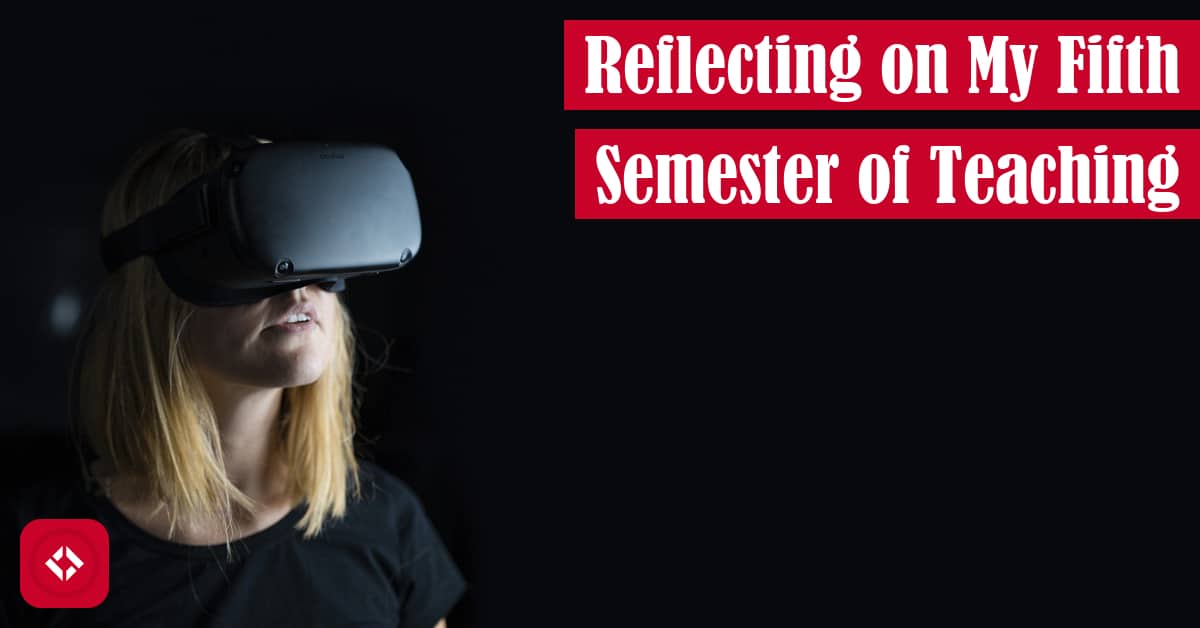With everything going on this semester—including a pandemic—I’m pretty sure my reflection is going to be a mess. What a wild fifth semester this has been.
As with all of my reflections, I’ll start by talking about the course I taught, what sort of feedback I’ve gotten, and how I plan to integrate that feedback into my future teaching. Feel free to skip around as needed.
Table of Contents
Logistics
Like last semester, I once again taught the Software Components (CSE 2221) course at The Ohio State University. As a result, not much was different. For instance, I was still teaching around 40 students, and the curriculum was roughly the same.
In addition, the schedule was pretty much the same. Specifically, I taught four times a week for 55-minutes a piece. However, unlike last semester, I had an early afternoon class which ran from 12:40 – 1:35 PM. As usual, lectures were on Tuesdays and Thursdays while labs were on Wednesdays and Fridays.
Now, the big difference between this semester and every previous semester was the pandemic of COVID-19. Before I get into that, here’s a little gem from Charles Cornell that’s sure to ease the tension (no musical pun intended):
At any rate, the beginning of the semester started just like any other semester. In fact, we almost made it to the second midterm before all the social distancing practices began. Then, spring break hit.
Just a few days into spring break, the university shut down. We were then all given an extended spring break, and students were asked to move out of their residence halls. In short, everything began to change very rapidly.
Over the remainder of spring break, faculty and folks like me were scrambling to come up with a plan. It seemed like every day we were getting new information.
Ultimately, we settled on a plan to make everything digital: lectures, labs, projects, assignments, and exams. Everything would be digital.
Then, from mid-March to the end of April, I was responsible for checking in on my students quite a lot. Without the regular structure, a lot of students sort of disappeared. Suddenly, I wasn’t able to provide the same level of support that I would have liked. Of course, I’ll take a bit more about that below in my reflection.
That said, the overall grades didn’t shake out too bad:
| Grade | Count |
|---|---|
| A | 5 |
| A- | 6 |
| B+ | 4 |
| B | 8 |
| B- | 6 |
| C+ | 0 |
| C | 0 |
| C- | 1 |
| D+ | 0 |
| D | 0 |
| E | 0 |
| EN | 0 |
| PA | 7 |
| NP | 2 |
In fact, I’m pleased with these grades because I think they correlate well with how the students performed in the course. Of course, some students didn’t agree (more on that later).
Also, in case you’re wondering, the PA and NP grades are PASS and NO PASS, respectively. These were special grades that students could receive due to the pandemic. In order to receive a PA, students had to get at least a D. Otherwise, they received an NP.
Reflection
Now that I’m closing out my last semester of teaching (at least for now), there’s a lot I’d like to reflect on. For instance, I’m thinking about writing an entire separate reflection which looks at all of my teaching experience.
For now, however, I’d like to reflect on just this class.
The Good
One thing I love about teaching is getting to experiment with teaching techniques. For example, I have slowly been building up a collection of peer instruction questions over the last two semesters, and I’ve really enjoyed testing them out in class. In particular, this semester I got to experiment with more difficult questions as I had a very high achieving class.
In addition, I got to do a lot of fun things this semester like host a Small Group Instructional Diagnostic (SGID) with my students. Naturally, I’ll talk about how that went in the feedback section below.
Other than that, I had a ton of great students this semester. For instance, I had one student who hadn’t missed a point until I jinxed them before the final quiz. Likewise, I had a ton of students who just wanted to chat about life and whatnot. I always appreciate it when students act like themselves.
Finally, I really enjoyed how flexible students were with my teaching. After all, the pandemic really threw a wrench in things, and I think my students were really thankful that I was hearing them out through the transition.
The Bad
If I had one bad thing to complain about this semester, it would have to be the pandemic. As someone who loves remote work, I should be happy about quarantine. Unfortunately, I forget that remote work usually means constant contact at all hours of the day. As a result, I constantly received emails from all sorts of folks (e.g. faculty, staff, students, etc.) containing information that was less than urgent.
Also, the transition was pretty abrupt, and the added stress didn’t exactly help my mental health. I was already trying to work out some burnout related things with a therapist, and going remote didn’t exactly help. Fortunately, I’m planning to take the entire month of May off, so that makes life easier.
All that said, it’s hard to complain about staying home when so many folks are suffering. Special thanks go out to all the folks who are fighting on the front lines during this pandemic. Hopefully, we can safely make our way through this together.
The Ugly
As with every semester, there seems to be a small group of students who refuse to due their own work. This is something I hate for a couple reasons:
- Cheating is a breach of trust between student and instructor. As a result, I feel less inclined to help students that cheat because I feel deceived. That’s not to say that I won’t continue to help them, but it is frustrating.
- Cheating involves a long and painful academic misconduct process. By cheating, students take away time that I could spend helping other students. In essence, cheating is a selfish act.
- Cheating delays or completely dismantles the learning process. If a students cheats and gets away with it, they’ll continue to do it until they’re so far along that they can’t possibly catch up.
All that said, I understand why students do it, and that’s why I often take blame for it. If I’m not doing a good enough job engaging my students, they may feel compelled to cheat. I’m not saying it’s right, but I understand why it happens.
That said, I will say that one of my students spent most of the semester plagiarizing work. Then, when I called them out on it, they began coming to office hours. By the end of the course, I think they actually understood what they were doing. This felt like a big win to me!
The Horrendous
Just about every semester I’ve been teaching, I’ve had at least one student who has actively tried to make my life more difficult. For instance, in my first semester, I had a student take advantage of my generosity by never adhering to a single deadline. As a result, I made a rule with myself to document everything.
Of course, that new rule backfired last semester when I had a student dissect everything I said to try to get a better grade. That’s when I realized that it’s not just important to document every conversation but also to be as explicit as possible to avoid misinterpretation. At this point, I feel like I should start studying law.
Now, this semester, I had a few students doing the same scummy things. That said, one of the students that frustrated me most was a student that constantly blamed the department for all of their problems. Got a bad grade on an assignment? It’s the department’s fault. Didn’t do well on an exam? It’s the department’s fault.
While I largely agree with this student’s frustrations, it’s ultimately up to them to put in the work and get through it—especially in my class where I give everyone the opportunity to succeed. For example, when the department decided to do away with participation points, I offered to let students turn in any homework they wanted, no questions asked. No other instructor did that.
Of course, that didn’t happened as this student was never proactive. Instead, they’d email me with every gripe they had after every assignment (as opposed to asking me for help before turning it in). To make matters worse, they were always wrong in their disputes. Typically, I’m happy to entertain student arguments, and I almost always award points to good arguments. Unfortunately, this student never had one.
That said, I thank these students because they help me refine my future course policies. If it weren’t for them, I’d never be able to anticipate similar behaviors in the future.
Feedback
With the reflection out of the way, let’s take a look at all the feedback I collected this semester. This time around, there will actually be three sections of feedback (and possibly more): SEIs, Course Evaluation Survey, and the SGID.
Course Evaluation Survey
As always, I like to pass out my own custom survey every semester. In that survey, I ask a bunch of Likert-style scale questions around the students’ experience in the course. Then, I close out the survey with some testimonial information.
Since I’m lazy, I don’t try to parse out the latest responses. Instead, all of the charts below will include all submissions since I started teaching.
Course Demographics
To kick things off, I always like to share how many people have taken the survey and from which classes:
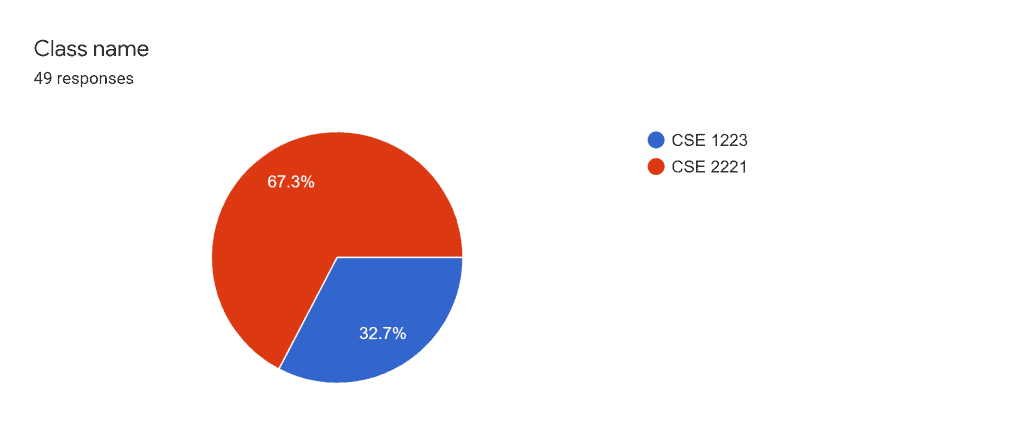
As you can see, over two-thirds of my survey is now made up of students from CSE 2221, the software components class. In total, I’ve received exactly 49 responses; I think that’s a fair assessment of my teaching over the past two years.
In addition, I have another plot that indicates why students selected this course:
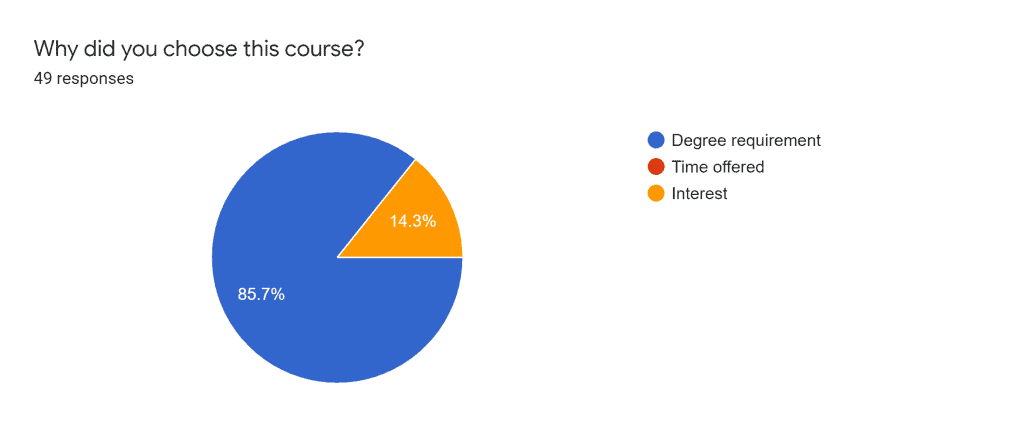
Clearly, most of my students are taking the class because they have to—their degree requires it. That said, I do occasionally get genuine interest.
Level of Effort
Next, we’ll take a look at how much effort students needed to put in to get through my courses. In this case, green and purple means more effort (forgive the terrible labels):
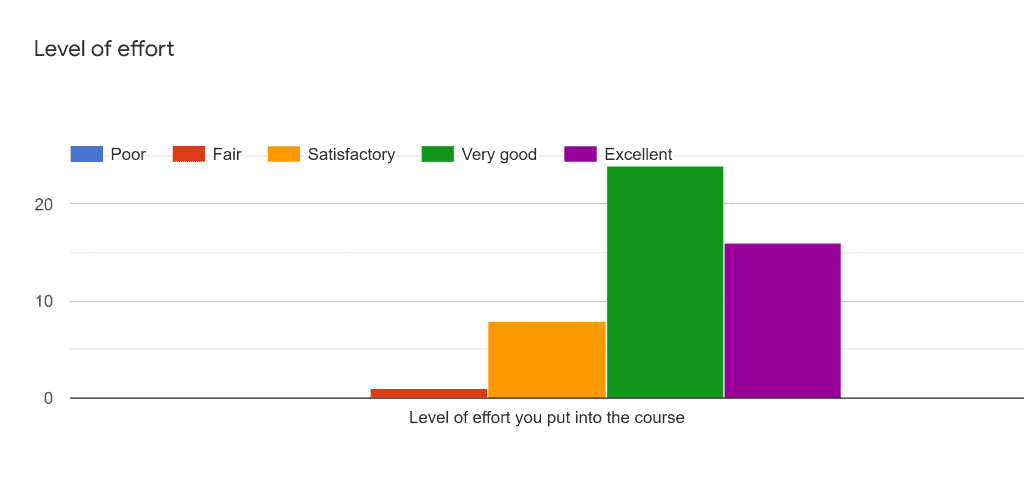
As you can see, not a single student in my two years of teaching felt the course was easy. In fact, most students felt they had to work pretty hard. Part of me wonders if the courses were too difficult or if there was just some mismatch in expectations coming into the course.
What’s interesting is that this is the first time I’ve seen a student admit that they didn’t put a lot of work into the course. I wonder if they felt the course was too easy or if they just didn’t care.
Contribution to Learning
After I get an idea of the students’ level of effort, I like to ask some questions about how much they felt the course contributed to their learning:
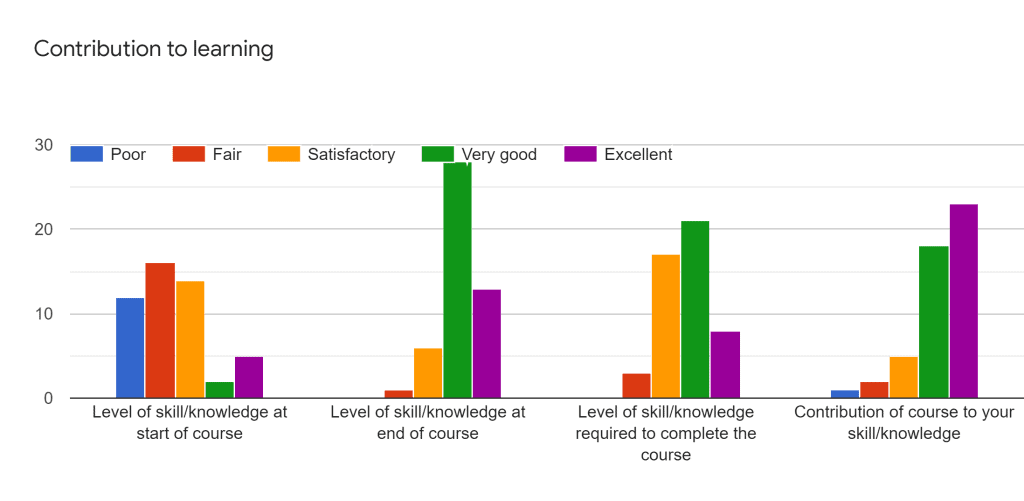
At this point, you can see we start to break the scale of our chart a bit. That said, there are a few noticeable trends. First, students almost always report some form of growth between the beginning and the end of the semester which is excellent. In addition, most students claim the course was the reason for their current knowledge.
What I find interesting is that more students are reporting that the course is pretty difficult. Since last semester, I now have more students reporting ‘Very Good’ as opposed to ‘Satisfactory’ for the ‘Level of skill/knowledge required to complete the course’ subscale.
Also, we’re starting to smooth out the level of knowledge at the beginning of the course curve. In particular, a few more students reported that they felt confident coming into the course than previous semesters.
Finally, not a single student reported ‘Poor’ for the ‘Level of skill/knowledge at end of course’ and ‘Level of skill/knowledge required to complete the course’ subscales. I think that’s a good sign!
Skill and Responsiveness of Instructor
Now that we’ve had a chance to look at how the course influenced the students, this section will cover how my teaching team and I affected the students:
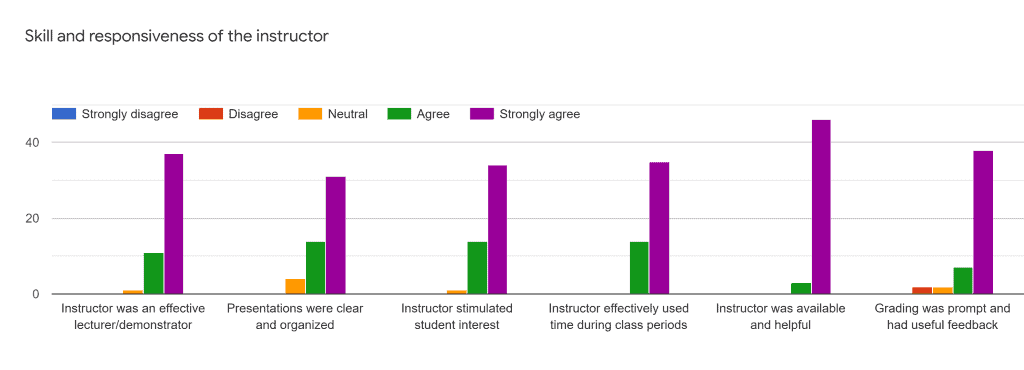
Once again, not much has changed. Students generally seem to think our team is doing the best we can.
Course Content
After I get an idea of how the teaching team is doing, I like to ask some questions about course content:
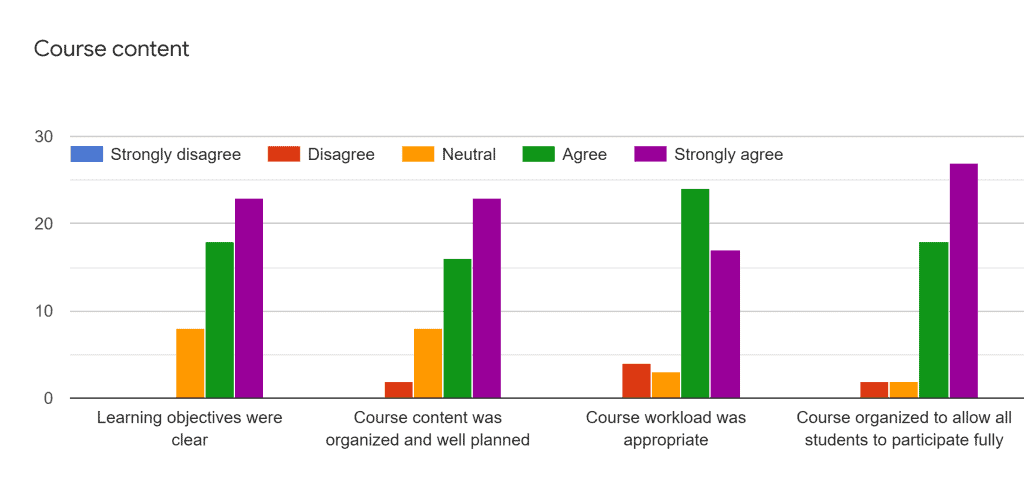
In general, I’m not seeing much of a change between last semester and this semester. If anything, more students are sort of neutral in their feelings around course content. In other words, nothing is really polarizing.
Value
At this point, I open it up to students to tell me “what aspects of this course were most useful or valuable?” This time around, I didn’t get a lot of positive feedback. However, one student did share the following:
Lectures: often times we discussed the mentality and approaches to problem solving that were useful throughout this course.
Anonymous, Spring 2020
Beyond that, I didn’t get much in terms of a response. That said, here are some of the raw comments:
- “The projects were a great learning experience.”
- “java/html”
- “OSU Components”
- “Using documentation”
Overall, I’m glad that students got something out of the course—even if it was something minor like getting practice through structured projects.
Improvements
To no surprised, I got quite a few responses to the question “how would you improve this course?” For instance, one student mentioned changing the structure of the class:
3 lectures and 1 lab (labs were useless IMO), More going over code in class (I.e. Jeremy shows us and writes his own code in class- but that’s a me thing).
Anonymous, Spring 2020
Meanwhile, another student mentioned something that I talk about a lot:
If there were less projects and bigger cumulative ones that would be worked on in labs and graded iteratively
Anonymous, Spring 2020
Likewise, one student seemed really upset with one of the assignments, but they didn’t really offer a solution:
Please please please fix the cryptoutilities project, the instructions are very unclear and confusing and the javadocs dont help at all.
Anonymous, Spring 2020
Beyond that, another student seemed upset with the way we assess their knowledge:
the exams/quizzes had very conceptual questions however the course really only taught practical coding
Anonymous, Spring 2020
In addition, I had one student raise some concerns about what’s “legal” in the course:
A formal list of Java classes that are allowed to be used for projects/homework.
JavaFX instead of Swing.
Anonymous, Spring 2020
Finally, one student mentioned clarity of course materials as a concern:
Better reading excerpts. A lot of exam questions were hard to understand with the very vague slides we were given
Anonymous, Spring 2020
At the moment, I don’t have much of a comment on these quotes. I’m really just presenting them for completeness. In the Changes section below, I’ll talk about what I plan to change (and also what I’d like to change).
Testimonials
After collecting some comments about the course, I like to take some time to fish for compliments. Specifically, I ask students to share their thoughts about me as an instructor. Of course, this is completely voluntary.
To kick things off, here’s a nice testimonial from a student who felt I did a great job but could probably make things even better:
I thought you were a super great teacher! I can tell that you care about your students and the material you teach. You have a good understanding of coding applications; although it seemed like you were a little uncomfortable with some of the OSU comps (I suppose since you’re more used to python, also natural numbers are stupid objects). My “advice” would be to write your own code in class during lectures (if time allows) since it shows students HOW somebody goes about analyzing a problem.
Anonymous, Spring 2020
Meanwhile, here’s just a bunch of kind words:
Definitely my best instructor this semester, very engadged with the class and you can tell he cares about teaching and really getting his students to learn.
Anonymous, Spring 2020
Great job!! Really sad to see you leaving CSE 🙁
Anonymous, Spring 2020
You have an unrivaled enthusiasm for teaching.
Anonymous, Spring 2020
Jeremy was very understanding and helpful throughout the course. He really wanted everyone to understand the material and do their best. I’m very thankful for his support and I really enjoyed his teachings. Jeremy was easily one of my favorite CS teachers. Thank you for such a great semester. Keep up the good work 🙂
Anonymous, Spring 2020
Overall, I’m thankful that students were able to still say something positive after this mess of a semester. These are the types of comments I turn to on a rough day!
Article Ideas
One thing I always ask my students is if they have any ideas for a future article. Unfortunately, I don’t usually get responses. However, I did get a couple this time!
For instance, one student recommended an article on Python for Java folks. That’s a cool idea!
Python for Java Users (moving from OOP to functional programming or something like that) / Java for Python Users. Best hidden data structures in Java/Python/C/C++…etc. (Maps are so good :D)
Anonymous, Spring 2020
Also, they recommended a good book for me that I’ll drop in the Amazon section at the bottom of this piece.
In addition, another student asked me to write about getting motivated to code. That’s also a really cool idea!
Maybe how to get motivated to code more or learn more coding? I always love coding when I’m doing it for an assignment but struggle to find motivation to code outside of class.
Anonymous, Spring 2020
Once I get some work done this month, I might try to put together a couple of these articles.
At any rate, that’s it for my survey. In the next section, we’ll take a look at the Small Group Instructional Diagnostic (SGID) that I completed this semester.
Small Group Instructional Diagnostic
In my list of ways to get feedback on your teaching, I shared an example of a Small Group Instructional Diagnostic (SGID), so I won’t go into the details. To summarize, however, a SGID is basically a class activity where students get to voice their opinions to an objective 3rd party. Then, that information is reported back to the instructor.
When I did it, I didn’t really hear anything new which was great news. It basically meant that I had a good pulse on the class. In other words, I knew what they liked and didn’t like. The challenge, of course, is making positive changes.
That said, here were some of the common themes:
- Most students appreciated the use of TopHat to facilitate asking questions and seeking clarification.
- Most students felt office hours was very helpful.
- Most students appreciated that labs were ungraded.
- Most students felt that they were thrown into projects without context.
Once again, I won’t really take the time to process this feedback here because it’ll just get rehashed in the changes section below.
Student Evaluation of Instruction
One thing that keeps me from publishing my reflections every semester are the Student Evaluations of Instruction (SEIs). To keep the reviews fair (though, we know they never are fair), students have to submit them before they get their final grades. Meanwhile, instructors have to wait to receive them until have final grades are posted. As a result, I’m just now adding the reviews (May 12th, 2020).
At any rate, the SEIs largely cover similar topics as my survey. In particular, however, they ask them in a 10-question format with an opportunity to give comments at the end. If your interested in seeing an official report, here’s mine from this semester.
That said, if you’re in a pinch, here are my scores in a table:
| Question | Instructor Mean | Department Mean | College Mean | University Mean |
|---|---|---|---|---|
| The subject matter of this course was well organized | 4.03 | 4.27 | 4.30 | 4.36 |
| This course was intellectually stimulating | 4.45 | 4.21 | 4.27 | 4.29 |
| This instructor was genuinely interested in teaching | 4.72 | 4.32 | 4.45 | 4.52 |
| The instructor encouraged students to think for themselves | 4.69 | 4.35 | 4.43 | 4.48 |
| The instructor was well prepared | 4.66 | 4.31 | 4.37 | 4.44 |
| The instructor was genuinely interested in helping students | 4.83 | 4.33 | 4.45 | 4.50 |
| I learned a great deal from this instructor | 4.62 | 4.10 | 4.19 | 4.25 |
| The instructor created an atmosphere conducive to learning | 4.55 | 4.16 | 4.27 | 4.36 |
| The instructor communicated the subject matter clearly | 4.48 | 4.13 | 4.20 | 4.30 |
| Overall, I would rate this instructor as | 4.76 | 4.26 | 4.37 | 4.45 |
Overall, I’m quite pleased with this scores. I had assumed they would be a lot worse with how things shook out with COVID-19.
That said, I think the most interesting part about this survey was how many of my students chose to leave me nice comments. I’ll just dump some of my favorites here:
I cant say enough about this instructor. One of the best I have seen – really interested in teaching, available to the students, and helped everyone really understand the nuances of programming – which is an important value in any teacher.
Anonymous, Spring 2020
Amazing friendly personality, easily approachable for asking questions, made you think about the problem and didn’t just give you the answer, and overall one of the best instructors I have ever had. We need more instructors like Jeremy at Ohio State.
Anonymous, Spring 2020
He knows about all the topics and was very flexible with how much he could be. He understood the struggles students were going through and helped as much he could. I will always recommend this instructor while he is still available
Anonymous, Spring 2020
Of course, I got my fair share of critiques as well! For instance, most students were frustrated with the format of the course, and they felt I didn’t do enough to work around those issues. That’s totally fair and something to think about.
That said, it’s hard not to be really happy with how these turned out—especially considering how little teaching I’ll be doing going forward. This was a nice way to end my brief tenure as a Graduate Teaching Associate.
In the next section, we’ll talk about things I’d like to change in the future.
Changes
Last time, I introduced this changes section, I placed it right after the reflection. This time, I think it’s more appropriate to place it just after looking through the feedback. That way, we can use the feedback to inform our changes.
Be More Explicit
As I mentioned above, one thing that has really caused me problems this semester is writing everything down. In the past, I had done it to ensure students couldn’t fight me on things I “said.” Now, students are using my words against me to argue for special treatment.
In the future, I plan to be as explicit as possible when outlining promises. Even more than that though, I needed to also follow through on these promises. In addition, I need to make sure that students are comfortable calling me out on those promises sooner rather than later. For example, I had one student get upset with me because I had submitted final grades before releasing final quiz solutions.
Overall, I just need to make sure that nothing is open to interpretation. I don’t mean to do this to be a jerk, but I just find it easier when expectations are clear. Hopefully, being more explicit also helps curb plagiarism issues.
Provide More Context
One thing that I struggled with this semester was lining up assignments with course material. In many cases, I didn’t prepare students enough for assignments, nor did debrief students after due dates. As a result, assignments often felt like something outside of the course.
In the future, I plan to work out times in my schedule to prepare/debrief assignments with the class. If possible, I’d also like to have worked solutions that I can go over with the students. Of course, these solutions cannot be public for plagiarism reasons.
Speaking of plagiarism, I think any sort of assignment help will ease the pressure of cheating. If I can get students ready to complete work well before the due date, they shouldn’t feel the need to cheat.
Prepare for Anything
If there is one thing this pandemic has taught me, it’s that educators need to be prepared for anything. In this semester alone, I had a student lose a loved one while another student was continuing to grieve the loss of a loved one. These are scary times, and everyone has to somehow navigate it.
One way to alleviate some of this pressure would be to design classrooms that are more flexible to students. In other words, students should be able to make their own decisions about how they want to be educated.
That said, I don’t think I’ve been inflexible. In fact, I’m probably one of the most flexible instructors that most students will have. The reason for that is I believe everyone deserves a chance to succeed, so it’s my job to ensure every students has that opportunity.
However, I think I can be better prepared in the future. Of course, I’m just not sure what that future looks like right now.
Adjust Curriculum
One thing I never had control over was curriculum. In general, I had to stick to a pretty strict schedule as assessments were meant to be aligned between various sections of the same course.
That said, now that I’m done teaching for a bit, I feel comfortable talking about some of the changes I would make if I were to run my own class.
First and foremost, I would change the assignment structure to be more iterative. Currently, we administer projects on a near-weekly basis. Then, we quickly turn around with feedback which students can implement in their future projects.
Unfortunately, that means students never really get a chance to polish previous projects. Instead, they’re left in a crude state.
Personally, I would prefer students have a chance to rework projects and learn from their mistakes. That way, we can build their confidence over time without punishing them.
As a result, I would reduce the project count to 5 at most and ask students to submit drafts with certain features complete. That way, they could get some feedback as they go, and we’d be keeping them to a schedule. If they choose not to take advantage of this feedback, that’s on them.
Beyond that, I’m not sure I’d change much. In general, I think the readings are good, and I think the homework is a nice way to review concepts. If anything, I’d make the course more group oriented. For example, I might push for groups in the lab, but I’d probably stick to solo projects.
With all that said, let’s talk about my plan moving forward.
Looking Forward
As I’ve mentioned a few times throughout this piece, this is my last semester of teaching for the foreseeable future. As a result, I’m probably going to do one large review of my teaching at least over the last two years.
Until then, here are some of my older reflections for your perusal:
If you like this sort of stuff, you’re welcome to help out by checking out my list of ways to grow the site. Otherwise, here are some additional teaching resources you can find on Amazon (ad):
- Culturally Sustaining Pedagogies: Teaching and Learning for Justice in a Changing World

- Culturally Responsive Teaching and The Brain: Promoting Authentic Engagement and Rigor Among Culturally and Linguistically Diverse Students

Once again, thanks for hanging out! I appreciate it.
Recent Posts
It's July 2024, and I have three chapters of my dissertation drafted! Two more and we'll be ready to defend.
In growing the Python concept map, I thought I'd take today to cover the concept of special methods as their called in the documentation. However, you may have heard them called magic methods or even...

